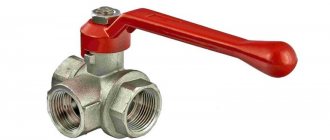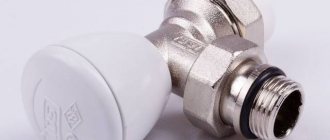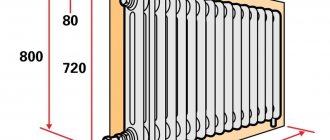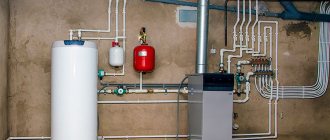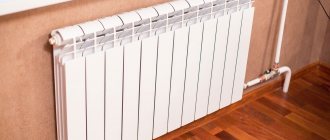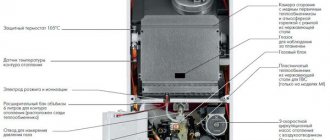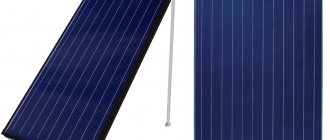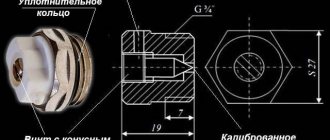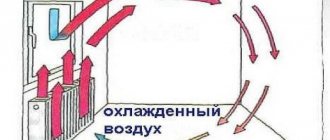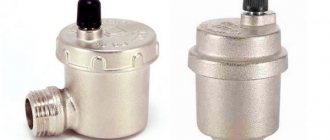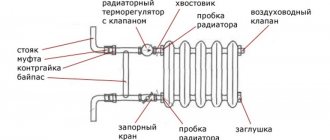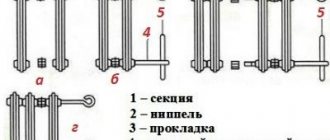Elevator unit
elevator unit of the heating system
If this parameter is lower, it is recommended to use modern plug valves, such as in the photo, since valves have serious disadvantages:
- it is necessary to periodically fill the oil seal, even when the valve is not in use, since the packing, in contact with water, is gradually destroyed;
- After a short period of time, the cheeks begin to become overgrown with deposits. If the valve sits for several years without being used, it will not be possible to close it completely;
- In the event of an emergency, every second can be decisive. If it takes literally a moment to close the plug valve, then it will take a long time to rotate the valve’s steering wheel, even when it is fully operational.
It should be noted that plug valves, which are a ball with a channel for water surrounded by a plastic shell, differ in:
- practicality;
- durability;
- reliable fluid retention;
- no need for maintenance.
They have significant design disadvantages:
Water hammer
Correct selection of control valves
Control valves for heating radiators are selected depending on the type of heating system and the requirements for its functionality. The radiator regulator can operate in manual or automatic mode. The principle of changing the heating of heating devices depends on the design of the device, which are divided into cone and valve.
When choosing a valve for a heating radiator, pay attention to the material of the body (steel, brass, a combination of these metals), the quality of the seals used - the reliability and durability of the products depends on this.
Types and models
There are the following types of valves that allow you to regulate the flow of coolant
:
- Cone mechanical. The simplest and cheapest option, the flow area of the device changes when the rod moves, for which it is necessary to manually adjust its position. It is recommended to use in conjunction with a thermometer. The weak point is the rubber gasket, which is prone to wear.
- Semi-automatic direct-acting thermostats. The position of the rod changes under the influence of a heat-sensitive element when the temperature of the coolant reaches the specified parameters. The value is set manually.
- Automatic thermostats. The rod is moved by servos, which are driven by a controller that receives a signal from a temperature sensor. Depending on the choice of the consumer, the device responds to the heating temperature of the coolant or air in the room.
When calculating the heating system, it should be taken into account that installing taps on radiators reduces the throughput of the system. You should select the appropriate pipe diameter or find taps with maximum throughput.
automatic thermostat
Popular brands
A good control valve is the key to the durability and reliability of the heating system. It is preferable to use products from reputable brands, which include
:
- Itap (Italy);
- Oventrop (Germany);
- Danfoss (Denmark);
- Luxor (Italy);
- Valtec (Italy and Russia, joint production).
The bodies of cheap shut-off and control valves are made of silumin - this alloy is characterized by increased fragility, such products are not recommended for use. The high-quality case is made of steel or brass, bronze.
Leading manufacturers use silicone seals instead of rubber gaskets. Unlike rubber, which loses elasticity due to high temperatures and crumbles under mechanical stress, silicone gaskets do not lose their functional properties throughout their entire service life.
Valve or shut-off valve
The valve can be called the brother of the gate valve. The device is activated by turning the flywheel, which transmits an impulse to the spindle, which begins to move forward and at the other end the spool, equipped with a gasket, closes. If the valve closes, then reaching the lower position, it rests against the seat, as a result of which the liquid is blocked (locked). This is where the name comes from - shut-off valve. Shut-off valves are widely used in water and fuel systems. They are shut-off and regulating and are presented in a wide variety of appearance and design. The service life varies from 20 to 30 years due to the quality of materials and operating characteristics. Wear occurs when 8 thousand closed-open cycles have been completed.
The devices also have their advantages and disadvantages. The advantages are determined by its operational characteristics:
- smooth regulation of water flow
- maintainability (replacement of the spool gasket or stuffing box gasket with its tightening);
- the presence of a smaller number of rubbing parts, which provides the valve with an increase in service life;
- the use of valves when regulating the flow of water to several objects (you simply cannot do without them) water and heat supply.
Disadvantages are characterized by a decrease in performance properties due to:
- increased hydraulic resistance, creating a stagnation zone where suspended particles can accumulate, which can cause premature wear and corrosion;
- failure of the spool gasket (separation by liquid flow, sticking, drying out), which leads to frequent repairs;
- the need to maintain the valve device in working condition, for which it should be completely opened or closed at least once a year if there has been no load in operation for a long time.
The exception to the rule here is a direct-flow valve with an inclined spindle, where less resistance is created in the hydraulics. This is achieved by the oriented position of the seat towards the fluid flow.
Connecting an electric boiler to a heating system
Scheme of inserting an electric boiler into a heating system
Before inserting an electric boiler into a heating system, you must read the installation instructions. Often the scheme does not differ from the standard ones - the only exception is ion boilers, which are characterized by their small size.
It should be immediately noted that illegal installation of any boilers into a central heating system is prohibited. This cannot be done even if the water heating level in the pipes is inappropriate. Otherwise, there is a high probability of a decrease in the efficiency of the system and failure of the boiler. It is possible to achieve the appropriate temperature conditions for heating operation only in the management company.
When connecting an electric boiler to an autonomous heating system, a connection should be made. It should consist of the following components:
- Pump. If it is already in the boiler, installation is not necessary;
- Distribution valve and balancing valve;
- Shut-off valves for the outlet and return pipes;
- Pressure gauge and thermometer.
A new connection to an existing heating pipe should only be carried out after the main boiler has been stopped. Otherwise it may cause it to break.
If an electric boiler is installed as an additional source of water heating, you must first correctly calculate its power. The operation of the device should optimize the temperature regime without disturbing it.
Ball valve and its device
Sectional view of a ball valve.
A ball valve is a type of shut-off valve that is designed to completely shut off the flow of coolant into a heating radiator. Using this device, it is impossible to regulate the amount of coolant supplied to the battery. The principle of operation of the mechanism is based on blocking the flow due to a locking element. Its function is performed by a ball with a through hole.
By turning the lever, a person turns the ball with a through hole inside the tap. Depending on the position of the latter, the flow of heated water into the heating circuit opens or closes. The lever can only be turned 90° in one direction or the other.
Ball locking mechanism.
Ball locking mechanism. As mentioned above, the locking mechanism here is a ball with a through hole. Sealing seats are placed on both sides of the ball. They perform two functions. Prevent coolant leakage into the pipe when the tap is closed. Provide the least resistance when turning the ball.
The locking mechanism is activated by turning the lever, which is located above the valve body. It is connected to the locking ball through a shaft (prevents the lever from being pulled out when the system pressure is high) and a washer (it is responsible for low sliding resistance when turning the shaft). The body of the device is made of either rolled steel or brass and its alloys.
Installation of ball valve. How to install a faucet on a radiator correctly? A specialist in his field will better answer this question, and therefore all work should be trusted only to him. If you plan to carry out the installation yourself, you need to take into account a number of nuances.
First, you need to choose the right faucet. For pipes whose diameter does not exceed 40-45 mm, a coupling device is suitable. For large diameter pipes (over 50 mm), flange valves (collapsible and monolithic) are purchased.
Thirdly, you need to clarify the type of tap thread and the direction of the coolant in it. The last parameter is easy to determine by the arrow, which is applied to the body of the locking mechanism. The tap thread can be internal or external on both sides. There are options where both types of thread are combined.
Work progress:
Questions about the operation of ball valves. During operation, people have a number of questions, which specialists are happy to answer. How to open the tap on a radiator at the beginning of the season? In this case, we are talking about the lower valve near the radiator, since the upper valve should be in the “open” position in the summer-autumn period.
Bypass is a pipe in front of the radiator that connects the supply and return.
So, before opening the tap on the radiator, you must wait 1 day after the start of the heating season. During these days, the quality of the coolant will noticeably improve. Then they proceed as follows: almost simultaneously, first the lower and then the upper locking mechanisms are opened. They wait a few minutes. If during this time the gurgling and gurgling in the radiator does not stop, then it is necessary to bleed the air from it. During the work, a Mayevsky crane is used.
How to replace the tap on a radiator? This question arises at the moment when the tap on the heating radiator is leaking. It’s bad if this is noticed after the start of the heating season and there is a centralized heat supply circuit in the room. After all, replacing the locking mechanism is carried out only when there is no coolant in the radiator. And only a technician from the organization providing the heat can drain the water from the system. In this case, the only solution to the problem is to call a technician to your home. It is not recommended to carry out work to replace a broken mechanism on your own.
If the heating battery tap is leaking in a private house where there is an autonomous heating circuit, then you can carry out the work yourself. But we must not forget about draining the coolant from the system. The work of replacing a faucet is no different from its original installation.
Faucet installation
Installing a shut-off device in heating radiators is a fairly simple procedure. To install absolutely any faucet, you will need a wrench or adjustable wrench of suitable size. Any heating radiator has four holes. A plug must be installed on each of them. To do this, you can purchase a set of plugs for piping radiators. Three plugs must be passable; taps and a device for venting air are installed on them. The fourth hole is closed with a plug.
The most common radiator piping scheme looks like this:
- A tap for water supply is installed at the top of the battery, and a “return” is installed on the same side below. Opposite the entrance, a valve is installed to discharge air, for example, Mayevsky’s system. The lower hole is closed with a blind plug.
- Regardless of which faucet you choose, it is inserted into the plug and tightened with a wrench. It is necessary to tighten the tap completely, but without applying excessive force. The fact is that almost all locking devices are made in a brass body. If you overtighten such a device, you can strip the threads or damage the housing. For greater tightness, flax thread is wound between the turns of the thread.
- The other side of the locking mechanism is connected to the heating system. If the pipes in the apartment are metal, then a threaded connection is used. If metal-plastic pipes are installed throughout the apartment, you will need an adapter coupling. After installation is completed, it is necessary to conduct a test supply of water to the system.
USEFUL INFORMATION: How to install a heated towel rail in the bathroom yourself
Why are there taps on radiators?
Each heating device is a separate element of the system that requires adjustment and periodic maintenance. If you control the coolant flow through the batteries depending on the heat demand, you can achieve good results in terms of energy savings. That is, radiator valves and heating taps are designed to solve the following problems:
- Complete isolation of the heating device from the system.
- Restriction of coolant flow through the battery.
- Change in coolant flow depending on external conditions.
- Bleeding air from the radiator and piping network.
There are many situations in which it is difficult to do without disconnecting the battery. For example, properly working central heating in the middle of spring, when it’s already warm outside, but it’s just hot in the apartment. Another case is the need to remove a heating device for the purpose of replacement, flushing or repair. In the absence of shut-off valves, carrying out any action with the radiator becomes problematic.
Valves are also installed on batteries in retro style
Restriction of the flowing coolant is carried out in order to balance individual heating in a private house or apartment
No matter what type of heating system you have, without balancing with valves, the first radiators will always receive more water than the last ones. Limiting the coolant flow at the beginning of the network and thereby balancing all devices with each other is the task of the control radiator fittings
Automatic control of the flow of incoming coolant is a way to save energy used to heat the house. If each tap on the heating radiator maintains the set air temperature in the room by controlling the flow of water through the radiator, then in general the system will consume only the required amount of heat, no more. And this is a considerable saving.
Well, the problem of air release when filling the system or during operation is also solved by special air valves installed on all modern radiators. Below is a list of types of shut-off and control valves, listed in the same order as the tasks they solve:
- Half-turn ball valves in straight and angle versions. Made from brass, bronze or polypropylene with a metal insert.
- Balancing valves for radiators – straight and angular.
- Regulating valves with thermal heads (thermostatic valves).
- Air drain valves – automatic and manual.
Now we should consider in detail which taps are best installed on radiators in various conditions and circumstances. Some options are clearly shown in the video:
https://youtube.com/watch?v=nnQz2VA7C_M
Thermal head
The next type of radiator tap is a thermal head for a heating radiator.
If there is a need to provide automatic temperature control, then using thermal heads together with a thermostatic valve will come in handy. This type allows you to adjust the optimal temperature without any human intervention.
Features of the functioning of the thermal head?
The thermal head functions inversely depending on the air temperature in the room. If the temperature increases (much higher than the comfortable and optimal temperature - this phenomenon can be observed when there are a large number of people in the room, or the operation of many electrical appliances), then the bellows of the thermal head expands. The expansion of the bellows of the thermal head leads to the fact that a certain part of the valve (stem) begins to move and there is a decrease in the flow of the heat generator through the radiator. If the air temperature, on the contrary, decreases, then this mechanism works in the opposite direction in order to increase the temperature for a comfortable and optimal temperature for the room.
Typical dimensions of thermal head valves
Basically, the typical and most common head size is M30*1.5. But the sizes are individual for each model. Today, manufacturers in most cases mark cranes, indicating their exact dimensions and production characteristics. The markings indicate special symbols with which the indicators are deciphered.
Installation of thermal heads
- Using certain rods, the plate is attached to the wall.
- The thermal head is fixed on the plate itself.
- Next, fixation is performed on the wall of the capillary tube.
- The thermal head is installed according to certain marks.
- Tighten and fix the bolt.
Features and differences between corner taps and straight taps, their advantages
What are the positive characteristics of corner taps?
- There is a guaranteed ability to turn off the battery.
- Resume operation of the heating system at any convenient time, if necessary.
- Guaranteed ability to independently adjust the temperature, which will be comfortable and optimal for being in the room (if there are temperature changes outside, and so on).
- The angle tap is very convenient to use, especially when draining a heat generator. This greatly reduces the time for this procedure.
- Easy maintenance.
When choosing between corner and straight taps, it is recommended to mainly use corner taps due to the above-mentioned positive features.
How to install a tap on a battery
Most often (due to ease of installation), the faucet is installed on the radiator using a threaded connection or (as it is popularly called) “American”. This device is a design with one or two union nuts. With their help, the tap is pressed against the pipe.
Most of the “American” ones are equipped with hex nuts. This allows you to use a regular wrench for tightening. But there are models equipped with two slots on the sides of the nut; in this case, you need to use a special wrench.
Do not forget that all shut-off valves are installed simultaneously with the installation of the radiator. If this is done on an already operating battery, then it is necessary to first drain the coolant, and for this you will have to shut off the heating riser. This service should be provided by the management company.
Installing a Mayevsky crane on a cast iron battery is also not difficult. Before installation, make sure that the plug has the correct hole for screwing in the device. The Mayevsky valve is installed in the end cap in the upper part of the radiator and on the side opposite the inlet. If the plug does not have the required place for installation, then you need to buy another one or drill an existing one and cut a thread in it.
Before installation, close the heating riser (or close the shut-off valves at the inlet and outlet of the battery). Then you need to drain the water. After this, you can replace the plug and screw in the tap. In this case, it is necessary to ensure that the tap hole faces away from the wall and slightly downwards. This will make it easier to remove accumulated air.
When installing any faucet, it is important to achieve complete tightness. For this it is better to use winders. When installing shut-off valves using “American”, you can use FUM tape, but only if the threads do not have sharp edges. If the thread design is not suitable, then you can use ordinary plumbing tow.
We would also like to bring to your attention some articles that may be useful to you:
- DIY battery screen.
- How to hide a radiator.
- How to hide a heating battery.
Furniture items
A few examples of furnishing a kitchen combined with a living room:
- 1. Sofa. It becomes an object that zones space. The sofa is placed with its back facing the place where food is prepared. In small rooms (less than 20 sq m) a corner is placed, which is placed against a wall installed perpendicular or parallel to the kitchen.
- 2. Set. According to designers, minimalist models without elaborate details look modern. The service, vases or glasses are placed on an open shelf. You can buy a fashionable display case for them. Furniture is placed near the wall. If the space is large (20 sq. m, 25 sq. m or 30 sq. m), then in the central part you can install an island, which also has sections for kitchen appliances.
- 3. Furniture set. The style should be combined with the design of both rooms. In small rooms, a compact table and chairs made of transparent material or painted in light colors look good. You can add a table with a round top to your living room interior. In spacious rooms, the kit is installed near the wall or in the central part. An elongated rectangular dining table would look good here.
Crane installation
The installation diagram depends on the type of shut-off and control valves selected.
Faucet installation process
The most common installation options are:
:
- In a single-pipe central heating system, 2 ball valves are installed between the radiator and the bypass - on the inlet and outlet pipes. This makes it possible to leave it filled when draining coolant from the system during network repairs, to disconnect or dismantle the battery for painting, cleaning, or replacement.
- In an autonomous two-pipe system, a thermostatic valve is placed on the supply pipe, and a balancing valve is installed on the return pipe, which will be responsible for maintaining normal operating pressure.
- In an autonomous one-pipe system, you can install a ball valve on the supply pipe, and a control valve on the return pipe. If the valve has a coolant flow cut-off function, a second ball valve on the heating radiator is not required.
Installation of ball valves
Ball valves, which are installed on a heating radiator, have two operating positions: “open” and “closed”. Partially blocking the coolant flow using this type of fittings is prohibited. As a result of improper operation, the device may fail and begin to leak.
The device can have a straight or angular design - the choice depends on the layout of the system. If the installation of regulators is not provided between the shut-off valves and the radiator, the ball valve can be installed directly on the heating device using a squeegee - a special additional part.
Before installation, make sure that the device parameters (working pressure, maximum permissible ambient temperature) correspond to the characteristics of the heating system. The direction of flow is indicated on the valve body - installation is carried out in accordance with the mark.
